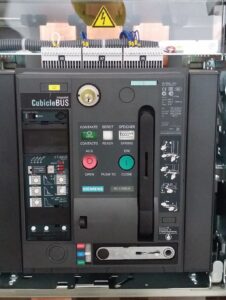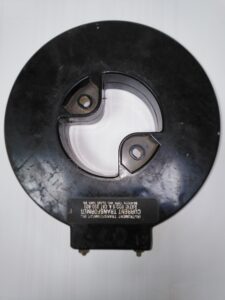Types of circuit breakers are classified into various terms. One of the most common methods of classifying circuit breakers is the arc extinction method.

-
Air Circuit Breakers (ACB): Air circuit breakers use air as the medium for arc extinction. They are typically used in low-voltage applications and are capable of protecting electrical circuits from overloads and short circuits. ACBs are known for their robustness, simplicity, and high breaking capacity. They are often used in commercial and industrial settings, where they provide reliable protection for electrical distribution systems.
-
Molded Case Circuit Breakers (MCCB): MCCBs are designed for low-voltage applications and are known for their compact size and reliable performance. They are often used in commercial and industrial settings to protect electrical circuits and equipment from overloads and short circuits. MCCBs typically have adjustable trip settings, allowing for customization based on specific application requirements.
-
Miniature Circuit Breakers (MCB): MCBs are commonly used in residential and light commercial applications. They are designed to protect electrical circuits from overloads and short circuits. MCBs are available in various current ratings and are characterized by their compact size and ease of installation. They are typically used in distribution boards to provide reliable protection for electrical wiring and appliances.
-
Residual Current Circuit Breakers (RCCB): RCCBs, also known as residual current devices (RCDs), are essential for protecting against electric shock. They monitor the imbalance of current between the live and neutral conductors. If an imbalance is detected, indicating a leakage current, the RCCB quickly disconnects the circuit to prevent electric shock. RCCBs are commonly used in residential and commercial installations, providing an additional layer of protection for individuals and equipment.
-
Residual Current Circuit Breakers with Overcurrent Protection (RCBO): RCBOs combine the features of an RCCB and an MCB. They provide both residual current protection and overcurrent protection in a single device. RCBOs are commonly used in applications where simultaneous protection against electric shock and overcurrent is required, providing comprehensive protection for both individuals and electrical circuits.
-
Ground Fault Circuit Interrupters (GFCI): GFCIs are specialized devices designed to protect against electric shock in areas where the risk of electrical hazards is high. They monitor the current flow in the live and neutral conductors and quickly interrupt the circuit if any imbalance is detected. GFCIs are commonly used in areas such as bathrooms, kitchens, and outdoor locations, where the presence of water or moisture increases the risk of electrical accidents.
-
Oil Circuit Breakers (OCB): OCBs use oil as the interrupting medium for extinguishing the arc. They were commonly used in high-voltage applications but have been largely replaced by newer technologies due to the environmental concerns associated with oil leaks and disposal. OCBs were known for their high interrupting capacity and reliability in high-voltage power systems.
-
Vacuum Circuit Breakers (VCB): VCBs use a vacuum as the interrupting medium for arc extinction. They are known for their high reliability, minimal maintenance requirements, and excellent performance in medium-voltage applications. VCBs are commonly used in distribution systems and industrial settings where reliable and efficient circuit protection is essential.
-
Sulfur Hexafluoride (SF6) Circuit Breakers: SF6 circuit breakers use sulfur hexafluoride gas as the interrupting medium. They are known for their excellent insulating and arc-quenching properties, making them suitable for high-voltage applications such as power transmission and distribution systems. SF6 circuit breakers are characterized by their high dielectric strength and thermal stability, which make them reliable for interrupting heavy fault currents.
Each type of circuit breaker serves a specific purpose and is designed to meet the safety and protection requirements of various electrical applications.
Understanding the characteristics and applications of these circuit breakers is essential for ensuring the safe and reliable operation of electrical systems and equipment.
Table of Contents
Air circuit breaker vs MCCB
Selecting electrical installation protective devices is critical to minimize difficulties caused by abnormal service circumstances. Both ACB and MCCB are used to ensure the safety of electrical systems.
Both serve the same goal in theory. Although there may be some similarities between these two devices, there are also some differences between them. Let us have a look.
|
Air CB |
MCCB |
|
ACB is an abbreviation for Air Circuit Breaker. |
MCB stands for Molded Case Circuit Breaker. |
|
ACBs are often utilized on the circuit’s upstream end. Because of its less frequent operation, the ACB is not suitable for use at the load end. |
MCCBs are used on the load side of the circuit to break the circuit in the event of a failure or any fault that might be harmful to the circuit. Because of its compatibility with regularly functioning with accuracy, the MCCB circuit can be employed at the load end. |
|
The ACBs for a circuit are chosen based on two parameters: the operating voltage and the fault voltage. ACB parameters perform worse than MCCBs. |
MCCBs are thought to be more accurate than ACBs due to the usage of different technologies in MCCBs. The advancement of technology has made circuit breakers more accurate and precise. |
|
The air circuit breaker has a lesser breaking efficiency than the MCCB. |
The MCCB outperforms the ACB in some areas, including breaking capability. |
|
The ACB has a higher rating than the MCCBs. Because of its high current rating, an ACB is employed in a circuit with a higher circuit current. There is a 6300 A rating for general ACBs at the present time. |
Depending on their features, MCCBs can have ratings higher or lower than this rating. There are approximately 3200 Amps of rated current for the MCCB. |
|
The tripping thresholds in the ACBs can be adjusted, although it’s a bit complicated. |
The MCCB’s tripping thresholds are easily adjustable. This characteristic makes the MCCB preferable to alternative circuit breakers in certain circuits. |
|
The ACB also has two modes of operation. The magnetic mode is one possibility, while the thermal magnetic mode is another. |
The MCCBs use thermal magnetic functioning. Previous MCCBs only had one operation, which was typically magnetic. |
|
The ACB’s trips unit might be the same as that of MCCBs. |
The units that have been tripped might be either magnetic or electrical. Thermal magnetic units can also be used as trip units. |
|
ACBs are rarely utilized in circuit breakers. |
MCCBs are more prevalent breakers than ACBs. |
Read my other article: What are MCB Types And Applications?
Why vacuum is used in circuit breakers?
Vacuum is used in circuit breakers for its high dielectric strength and excellent insulating properties. When a circuit breaker operates, it needs to interrupt the flow of electric current in a safe and controlled manner. Vacuum has the ability to extinguish the electrical arc that forms when the contacts of the circuit breaker separate, thereby effectively quenching the arc.
Here are some key reasons why a vacuum is used in circuit breakers:
-
High Dielectric Strength: Vacuum has a high dielectric strength, meaning it can withstand high electric fields without undergoing electrical breakdown. This property is crucial in preventing the formation of an electric arc during the circuit interruption process.
-
Excellent Insulation Properties: Vacuum serves as an effective insulator, preventing the occurrence of electrical conduction between the contacts when they are open. This property ensures that the circuit remains open, and current does not flow when the breaker is in the off state.
-
Minimal Maintenance Requirements: Vacuum circuit breakers have minimal maintenance requirements compared to other types of circuit breakers, making them a cost-effective and reliable option for various applications. Their simple design and the absence of an insulating and arc-quenching medium result in reduced wear and tear, contributing to their long service life.
-
High Reliability: Vacuum interrupters have a high degree of reliability and operational stability. They are capable of handling frequent operations and interruptions without significant deterioration in performance, making them suitable for applications where operational reliability is essential.
-
Environmental Friendliness: Unlike some other types of circuit breakers, vacuum circuit breakers do not utilize environmentally harmful substances, such as oil or sulfur hexafluoride (SF6). This characteristic makes them a more environmentally friendly option, aligning with the growing emphasis on sustainable and eco-friendly technologies.
Overall, the use of vacuum in circuit breakers allows for efficient and reliable interruption of electrical current, ensuring the safe and effective operation of electrical systems in various applications, including distribution systems, industrial settings, and power generation facilities.
How to check the vacuum in a vacuum circuit breaker?
Checking the vacuum in a vacuum circuit breaker typically involves performing specific tests to assess the integrity and performance of the vacuum interrupter. Here are the general steps for checking the vacuum in a vacuum circuit breaker:
-
Visual Inspection: Conduct a visual inspection of the vacuum interrupter for any signs of damage, such as cracks, leaks, or contamination. Ensure that the seals are intact and that there are no visible signs of degradation or wear.
-
Contact Resistance Test: Perform a contact resistance test to check the electrical integrity of the contacts within the vacuum circuit breaker. Elevated contact resistance can indicate problems with the contacts or the vacuum interrupter, necessitating further investigation.
-
Insulation Resistance Test: Conduct an insulation resistance test to evaluate the insulation properties of the vacuum interrupter. This test helps identify any potential insulation degradation or moisture ingress that could compromise the vacuum integrity.
-
Pressure Rise Test: Perform a pressure rise test to assess the internal pressure within the vacuum interrupter during the operation of the circuit breaker. An abnormal pressure rise could indicate a potential leak or deterioration of the vacuum, requiring further analysis.
-
Opening and Closing Time Tests: Check the opening and closing times of the vacuum circuit breaker to ensure that it operates within the specified time frame. Deviations from the standard operating times might indicate issues with the vacuum interrupter or the operating mechanism.
-
Vacuum Integrity Test: Perform a vacuum integrity test, such as a helium leak test or a mass spectrometer test, to assess the vacuum level and the presence of any leaks within the vacuum interrupter. This test helps identify any potential weaknesses or breaches in the vacuum enclosure.
-
Operational Test: Finally, conduct an operational test of the vacuum circuit breaker under typical operating conditions to ensure that it functions correctly and responds appropriately to electrical faults or overloads.
It is essential to follow the manufacturer’s guidelines and recommended testing procedures when checking the vacuum in a vacuum circuit breaker.
Regular maintenance and testing of the vacuum interrupter are crucial to ensure the reliable and safe operation of the circuit breaker and to prevent any potential failures or malfunctions.
If any anomalies or abnormalities are detected during the testing process, it is advisable to consult a qualified technician or engineer for further assessment and necessary repairs.
Where is the SF6 circuit breaker used?
SF6 (sulfur hexafluoride) circuit breakers are commonly used in high-voltage applications where their unique properties make them well-suited for specific requirements. Some of the primary applications of SF6 circuit breakers include:
-
Power Transmission and Distribution Systems: SF6 circuit breakers are frequently used in power transmission and distribution systems, particularly in high-voltage applications such as substations and power generation facilities. Their high dielectric strength and excellent arc-quenching properties make them suitable for interrupting heavy fault currents and ensuring the reliable and efficient transmission of electricity over long distances.
-
Industrial Facilities and Manufacturing Plants: SF6 circuit breakers find application in various industrial settings and manufacturing plants where high-voltage equipment and systems are used. They are employed to protect critical electrical equipment from overloads and short circuits, ensuring uninterrupted operation and preventing damage to machinery and production processes.
-
Railway Systems: SF6 circuit breakers are utilized in railway systems for the protection of electrical equipment and infrastructure, including railway substations and power distribution networks. They play a crucial role in ensuring the safe and reliable operation of railway systems, contributing to the efficiency and safety of railway transportation.
-
Mining Operations: In mining applications, SF6 circuit breakers are used to safeguard electrical systems and equipment in underground mining operations, where reliable and robust circuit protection is essential for maintaining the safety and productivity of mining activities.
-
Large Commercial and Institutional Buildings: Certain large commercial and institutional buildings, such as data centers and hospitals, may utilize SF6 circuit breakers to protect their electrical infrastructure and critical systems. These circuit breakers help prevent electrical faults and ensure the continuous operation of essential equipment and services within these facilities.
SF6 circuit breakers are known for their high performance, reliability, and ability to handle heavy electrical loads, making them suitable for demanding applications where the interruption of electrical currents must be precise and reliable.
However, due to environmental concerns associated with SF6 gas, efforts are being made to explore alternative technologies and eco-friendly solutions for circuit protection in various high-voltage applications.
why SF6 is used in circuit breakers
SF6 (sulfur hexafluoride) is used in circuit breakers for several key reasons, primarily due to its unique properties that make it an ideal choice for interrupting electrical currents in high-voltage applications. Some of the main reasons why SF6 is used in circuit breakers include:
-
High Dielectric Strength: SF6 has excellent dielectric properties, enabling it to withstand high electric fields without ionizing. This property allows it to maintain a non-conductive state even when exposed to high voltages, making it an effective insulating medium for high-voltage circuit breakers.
-
Superior Arc-Quenching Capability: SF6 has exceptional arc-quenching properties, allowing it to rapidly extinguish electrical arcs when the circuit breaker operates. This property ensures that the circuit interruption occurs swiftly and reliably, preventing damage to the electrical equipment and ensuring the safety and stability of the power system.
-
Chemical Stability: SF6 is chemically inert and non-flammable, making it a stable and safe gas to use in electrical applications. Its chemical stability prevents the formation of by-products that could affect the performance of the circuit breaker, ensuring consistent and reliable operation over extended periods.
-
High Thermal Conductivity: SF6 has high thermal conductivity, enabling efficient heat dissipation during the arc-extinction process. This characteristic allows for the rapid cooling of the arc plasma, facilitating the quick recovery of dielectric strength and enabling the circuit breaker to withstand repeated operations without degradation.
-
Compact Design: SF6 circuit breakers can be designed with compact and lightweight structures, making them suitable for installation in space-constrained environments, such as substations and high-voltage power transmission facilities. Their compact design allows for efficient integration into electrical systems while maintaining high performance and reliability.
While SF6 offers exceptional electrical properties that make it a preferred choice for high-voltage circuit breakers, its use has raised concerns due to its high global warming potential (GWP) and potential environmental impact.
Efforts are being made to explore alternative gases and technologies that can provide similar performance while minimizing the environmental footprint associated with SF6.
How do you check for SF6 gas leaks?
To check for SF6 gas leaks, you can use various methods and specialized equipment. Here are some common techniques used for detecting SF6 gas leaks:
-
Soap Solution: This method involves applying a soap solution to the potential leak area. If there is a gas leak, the escaping SF6 gas causes bubbles to form in the soap solution, indicating the presence of a leak.
-
Electronic Leak Detectors: Portable electronic leak detectors specifically designed for detecting SF6 gas can be used to identify leaks quickly and accurately. These devices are highly sensitive to SF6 gas and can detect even small concentrations of the gas in the air.
-
Thermal Imagers: Infrared thermal imaging cameras can be used to identify SF6 gas leaks based on temperature differentials. SF6 gas leaks often result in temperature variations in the surrounding area, which can be detected using a thermal imager.
-
Ultrasonic Detectors: Ultrasonic leak detectors can be used to locate SF6 gas leaks by detecting the high-frequency sound generated by the gas as it escapes from the system. These detectors can pinpoint the exact location of the leak, facilitating prompt repairs.
-
Gas Detectors and Analyzers: Gas detection instruments equipped with specific SF6 sensors can be used to measure SF6 gas concentrations in the air. These devices provide precise readings of the gas concentration, helping to identify the presence of leaks and assess their severity.
-
Portable Gas Monitors: Handheld gas monitors capable of detecting SF6 gas can be used to perform on-site checks for leaks. These monitors are equipped with sensitive sensors that can detect even trace amounts of SF6 gas, ensuring comprehensive leak detection.
When conducting SF6 gas leak detection, it is essential to follow appropriate safety precautions and guidelines.
Additionally, regular inspections and maintenance of equipment and systems containing SF6 gas can help prevent leaks and ensure the safe and efficient operation of the equipment.
If a leak is detected, it is important to take immediate action to mitigate the leak and repair any faulty components or connections to prevent further gas emissions.
I have written detailed articles about, Bad circuit breakers, signs and causes, and what causes a circuit breaker tripping.
Don’t Leave Empty-Handed!
Install my Free Android App on Google Play:
Electrical Cables Most Common Tables “Cables Tables”
And, my Electrical Calculations App “Fast Electrical Calculator”
Discover more great content by subscribing to My channel
Looking to stay ahead of the game in the world of electrical engineering? Subscribe to my YouTube channel and gain access to exclusive content you won’t find anywhere else!
The staff I recommend
(Amazon Affiliate Links to products I believe are high quality):
- Economy 120 Volt/60Hz AC Power Source – Step-Down Voltage & Frequency Converters 1800W
- UNI-T Digital Multimeter Tester UT139C
- 50-Amp Extension Cord for RV “100ft”
- Voltage Stabilizer 110/220v
- Hair Dryer “best selling“
- TOSHIBA EM131A5C-BS Countertop Microwave Ovens
Disclaimer: This contains affiliate links to Amazon products. I may earn a commission for purchases made through these links.





